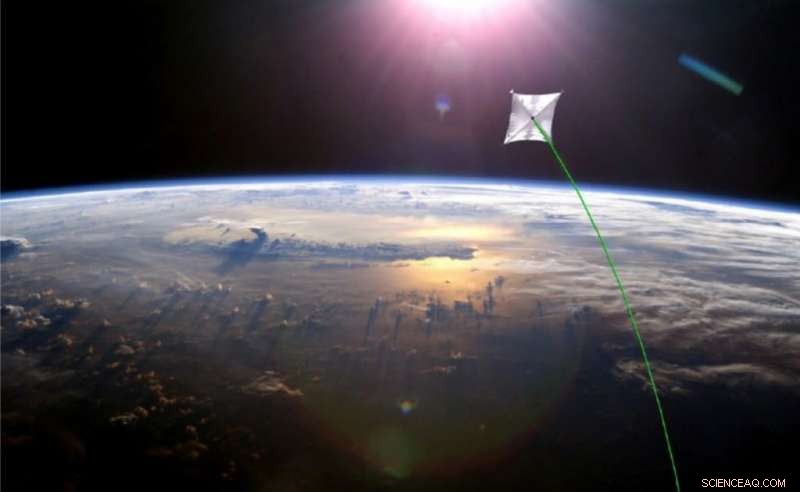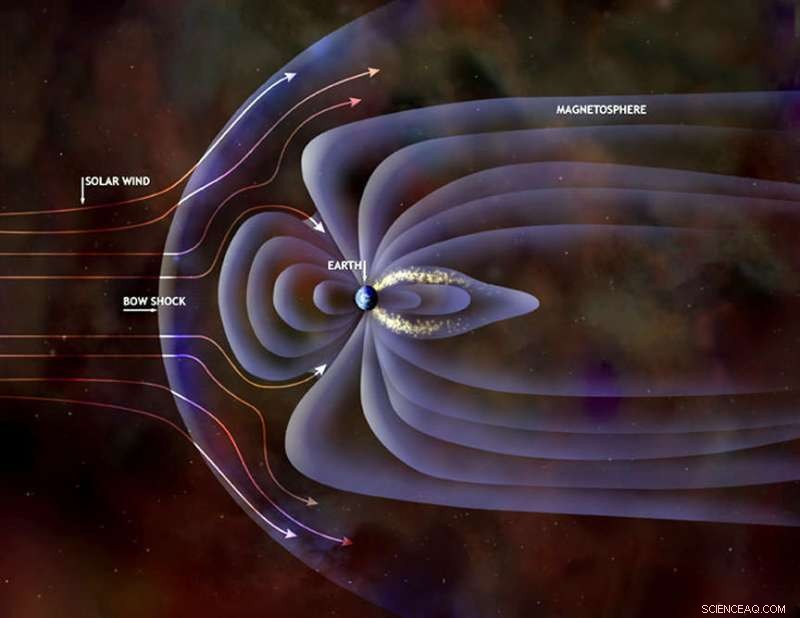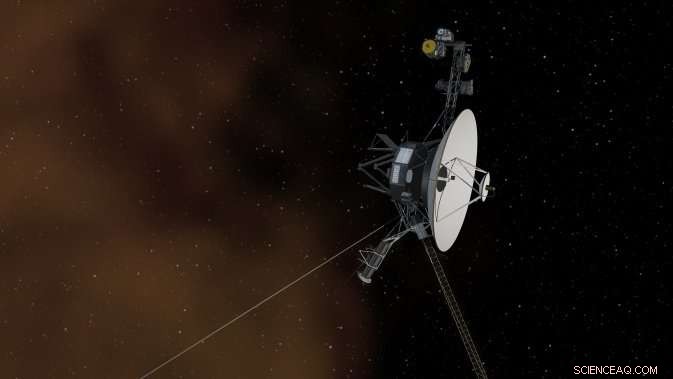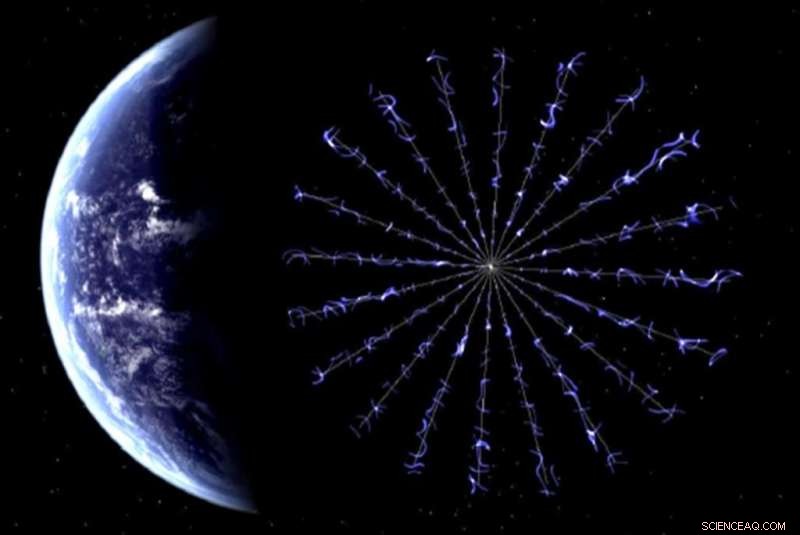
Concetto artistico di una missione dimostrativa di vela solare che utilizzerà i laser per la navigazione. Credito:NASA
Conosciamo tutti l'idea delle vele solari per esplorare il sistema solare, sfruttando la leggera pressione del sole. Ma c'è un altro sistema di propulsione che potrebbe sfruttare la potenza del sole, vele elettriche, ed è un'idea piuttosto eccitante.
Poche settimane fa, Ho risposto a una domanda che qualcuno aveva sui miei sistemi di propulsione esotici preferiti, e ho snocciolato alcune idee che trovo entusiasmanti:vele solari, razzi nucleari, motori a ioni, ecc. Ma c'è un altro sistema di propulsione che continua a salire, e ho completamente dimenticato di menzionare, ma è una delle migliori idee che ho sentito da un po':le vele elettriche.
Come probabilmente sai, una vela solare funziona sfruttando i fotoni di luce che fluiscono dal sole. Sebbene i fotoni siano privi di massa, hanno slancio, e possono trasferirlo quando rimbalzano su una superficie riflettente.
Oltre alla luce, il sole emette anche un flusso costante di particelle cariche:il vento solare. Un team di ingegneri dalla Finlandia, guidato dal dottor Pekka Janhunen, ha proposto di costruire una vela elettrica che utilizzerà queste particelle per trasportare veicoli spaziali nel sistema solare.
Per capire come funziona, Avrò bisogno di inserire alcuni concetti nel tuo cervello.
Primo, il Sole. Quella micidiale palla di radiazioni nel cielo. Come probabilmente sai, c'è un flusso costante di particelle cariche, principalmente elettroni e protoni, sfrecciando via dal sole in tutte le direzioni.
Gli astronomi non sono del tutto sicuri di come, ma qualche meccanismo nella corona del sole, la sua atmosfera superiore, accelera queste particelle su una velocità di fuga. La loro velocità varia da 250 a 750 km/s.
Il vento solare si allontana dal sole, e fuori nello spazio. Vediamo i suoi effetti sulle comete, dando loro la caratteristica coda, e forma una bolla attorno al sistema solare nota come eliosfera. È qui che il vento solare del sole incontra i venti solari collettivi delle altre stelle della Via Lattea.
Infatti, La navicella spaziale Voyager della NASA ha recentemente attraversato questa regione, finalmente si fanno strada nello spazio interstellare.
Il vento solare provoca una pressione diretta, come un vero vento, ma è incredibilmente debole, una frazione della leggera pressione che subisce una vela solare.
Ma il vento solare è caricato negativamente, e questa è la chiave.
Una vela elettrica funziona srotolando un filo incredibilmente sottile, solo 25 micron di spessore, ma lungo 20 chilometri. La navicella è dotata di pannelli solari e un cannone elettronico che impiega poche centinaia di watt per funzionare.

Visualizzazione del vento solare che incontra le "difese" magnetiche della Terra note come magnetosfera. Le nuvole di plasma rivolte verso sud sono in grado di staccare gli strati della bolla rivolta verso il Sole e impilarli in strati sul lato notturno del pianeta (centro, Giusto). Gli strati possono essere schiacciati abbastanza strettamente da riconnettersi e fornire elettroni solari (scintille gialle) direttamente nell'atmosfera superiore per creare l'aurora. Credito:JPL
Lanciando elettroni nello spazio, la navicella mantiene uno stato di carica altamente positivo. Quando le particelle caricate negativamente dal sole incontrano il cavo caricato positivamente, lo "vedono" un enorme ostacolo di 100 metri di diametro, e sbatterci contro.
Imprimendo il loro slancio al cavo e all'astronave, gli ioni lo accelerano allontanandosi dal sole.
La quantità di accelerazione è molto debole, ma è una pressione costante del sole e può accumularsi per un lungo periodo di tempo. Per esempio, se una navicella spaziale da 1000 kg avesse 100 di questi fili che si estendono in tutte le direzioni, potrebbe ricevere un'accelerazione di 1 mm al secondo al secondo.
Nel primo secondo percorre 1 mm, e poi 2 mm nel secondo successivo, ecc. Nel corso di un anno, questo veicolo spaziale potrebbe andare a 30 km/s. Solo per confronto, la navicella spaziale più veloce là fuori, Voyager 1 della NASA, sta solo andando a circa 17 km/s. Così, più veloce, decisamente su una velocità di fuga dal sistema solare.
Uno degli svantaggi del metodo, in realtà, è che non funzionerà all'interno della magnetosfera terrestre. Quindi un'astronave elettrica a vela dovrebbe essere trasportata da un razzo tradizionale lontano dalla Terra prima che possa spiegare la sua vela e dirigersi nello spazio profondo.
I'm sure you're wondering if this is a one-way trip to get away from the sun, but it's actually not. Just like with solar sails, a electric sail can be pivoted. Depending on which side of the sail the solar wind hits, it either raises or lowers the spacecraft's orbit from the sun.

This artist’s concept shows the Voyager 1 spacecraft entering the space between stars. Interstellar space is dominated by plasma, ionized gas (illustrated here as brownish haze), that was thrown off by giant stars millions of years ago. Credito:NASA
Strike the sail on one side and you raise its orbit to travel to the outer solar system. But you could also strike the other side and lower its orbit, allowing it to journey down into the inner solar system. It's an incredibly versatile propulsion system, and the sun does all the work.
Although this sounds like science fiction, there are actually some tests in the works. An Estonian prototype satellite was launched back in 2013, but its motor failed to reel out the tether. The Finnish Aalto-1 satellite was launched in June 2017, and one of its experiments is to test out an electric sail.
We should find out if the technique is viable later this year.
It's not just the Finns who are considering this propulsion system. Nel 2015, NASA announced that they had awarded a Phase II Innovative Advanced Concepts grant to Dr. Pekka Janhunen and his team to explore how this technology could be used to reach the outer solar system in less time than other methods.
The Heliopause Electrostatic Rapid Transit System, or HERTS spacecraft would extend 20 of these electric tethers outward from the center, forming a huge circular electric sail to catch the solar wind. By slowly rotating the spacecraft, the centrifugal forces will stretch the tethers out into this circular shape.
With its positive charge, each tether acts like a huge barrier to the solar wind, giving the spacecraft an effective surface area of 600 square kilometers once it launches from the Earth. As it gets farther, from Earth, anche se, its effective area increases to the equivalent of 1, 200 square km by the time it reaches Jupiter.

Artist’s illustration of NASA’s Heliopause Electrostatic Rapid Transit System. Credito:NASA
When a solar sail starts to lose power, an electric sail just keeps accelerating. Infatti, it would keep accelerating out past the orbit of Uranus.
If the technology works out, the HERTS mission could reach the heliopause in just 10 years. It took Voyager 1 35 years to reach this distance, 121 astronomical units from the sun.
But what about steering? By changing the voltage on each wire as the spacecraft rotates, you could have the whole sail interact differently on one side or the other to the solar wind. You could steer the whole spacecraft like the sails on a boat.
In September 2017, a team of researchers with the Finnish Meteorological Institute announced a pretty radical idea for how they might be able to use electric sails to comprehensively explore the asteroid belt.
Instead of a single spacecraft, they proposed building a fleet of 50 separate 5-kg satellites. Each one would reel out its own 20 km-long tether and catch the sun's solar wind. Over the course of a 3-year mission, the spacecraft would travel out to the asteroid belt, and visit several different space rocks. The full fleet would probably be able to explore 300 separate objects.
Each spacecraft would be equipped with a small telescope with only a 40 mm aperture. That's about the size of a spotting scope, or half a pair of binoculars, but it would be enough to resolve features on the surface of an asteroid as small as 100 meters across. They'd also have an infrared spectrometer to be able to determine what minerals each asteroid is made of.

This image depicts the two areas where most of the asteroids in the solar system are found:the asteroid belt between Mars and Jupiter, and the trojans, two groups of asteroids moving ahead of and following Jupiter in its orbit around the sun.
That's a great way to find that $10 trillion asteroid made of solid platinum.
Because the spacecraft would be too small to communicate all the way back to Earth, they'd need to store the data on board, and then transmit everything once they came past our planet 3 years later.
The planetary scientists I've talked to love the idea of being able to survey this many different objects at the same time, and the electric sail idea is one of the most efficient methods to do it.
Secondo i ricercatori, they could do the mission for about $70 million, bringing the cost to analyze each asteroid down to about $240, 000. That would be cheap compared to any other method proposed of studying asteroids.
Space exploration uses traditional chemical rockets because they're known and reliable. Sure they have their shortcomings, but they've taken us across the solar system, to billions of kilometers away from Earth.
But there are other forms of propulsion in the works, like the electric sail. And over the coming decades, we're going to see more and more of these ideas put to the test. A fuel free propulsion system that can carry a spacecraft into the outer reaches of the solar system? Yes please.